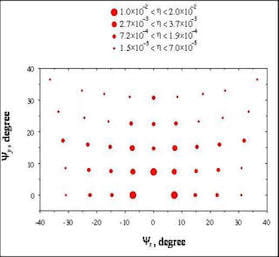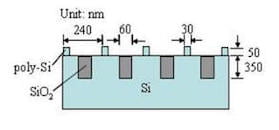The ability to manufacture, control, and manipulate structures at extremely small scales is the hallmark of modern technologies, which include microelectronics, MEMS/NEMS, and nanobiotechnology. Spectral and directional control of thermal radiation is a challenging yet important task for a number of applications, such as thermophotovoltaic (TPV) energy conversion, solar energy utilization, space thermal management, and high-efficiency incandescent lamps. The key to the enhancement of performance is through the modification of the reflection and emission spectra using one-, two-, or three-dimensional micro/nanostructures [1]. Pattern-induced radiative property variations can be an important problem for the wafer temperature measurement and the temperature uniformity control during integrated circuit manufacturing. In addition, light diffraction can be used to monitor the etching depth and other features during the microfabrication and lithographic processes.
We have fabricated both 1-D and 2-D periodically patterned microstructures using silicon microfabrication technology. The bidirectional reflection was measured using the three-axis automatic scatterometer, developed in our lab (see facilities). Figure 4 shows the bidirectional reflection of the 2-D microstructured silicon surface. The grating period is 5 mm in both directions and the wavelength is 535 mm. There are 2.25 million square structures in a single sample of an area of 7.5 ´ 7.5 mm2. The differently sized circles in Fig. 4b indicate different ranges of the power ratio, averaged over the two polarizations. The diffraction pattern is symmetric with respect to yx = 0° and nearly symmetric along the diagonal. The angular locations of the diffraction measurements are in excellent agreement with the prediction. The result may serve as a benchmark for the validation of 3-D rigorous electromagnetic wave models for 2-D microstructures.


Figure 1. (a) SEM imaging of 2-D microfabricated structure on silicon, and (b) the diffraction pattern at normal incidence.
In the flashlamp thermal processing, the heating cycle is on the order of a millisecond. It is very important to determine the radiative properties of the patterned structures in order to assess the thermal budget and temperature uniformity. We have calculated the radiative properties of patterned wafers with the smallest dimension down to 30 nm [3]. The effects of wavelength, polarization, and angle of incidence on selected periodically patterned wafers have been investigated. The rigorous coupled-wave analysis (RCWA) and two effective medium approaches (EMA-1 and EMA-2) are used. Figure 2 shows the normal absorptance of the 1-D patterned structure, shown on the left, for a TE wave, that is, the electric field is parallel to the grooves. The absorptance is a complicated function of wavelength due to the variation of the dielectric function of silicon and the unique effect of gratings. The use of EMA may result in a large error in the predicted radiative properties [3]. Further research is needed to determine the impact of the overall absorption on the wafer temperature distribution.


Figure 2. Predicted reflectivity at normal incidence for the structure shown on the left.
In the future, complex grating structures will be constructed using heavily doped silicon as wavelength selective emitters and absorbers for radiative energy conversion and thermal radiation detection. Particular attention will be paid to the study of the near-field effect on the far-field performance of these device structures. The radiative properties of patterned waves will be measured and compared with the prediction to assist the evaluation and development of very short-time thermal manufacturing of semiconductor devices.
This work has been supported by the National Science Foundation.
Selected Publications
[1] Zhang, Z.M., Fu, C.J., and Zhu, Q.Z., 2003, “Optical and Thermal Radiative Properties of Semiconductors Related to Micro/Nanotechnology,” Advances in Heat Transfer, 37, pp. 179-296.
[2] Chen, Y.B., Zhu, Q.Z., Wright, T.L., King, W.P., and Zhang, Z.M., 2004, “Bidirectional Resection Measurements of Periodically Microstructured Silicon Surfaces,” International Journal of Thermophysics, 25, pp. 1235-1252.
[3] Chen, Y.-B., Zhang, Z.M., and Timans, P.J., 2005, “Radiative Properties of Patterned Wafers with Linewidth below 100 nm,” to be presented at the International Mechanical Engineering Congress and Exposition, November 5-11, 2005, Orlando, FL.